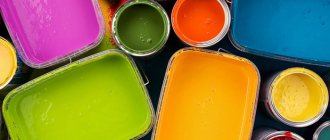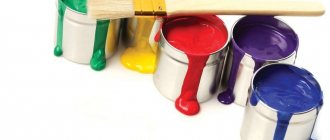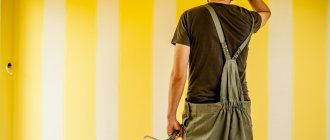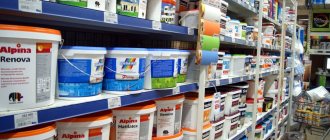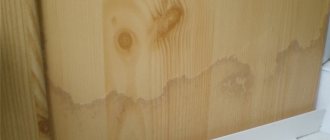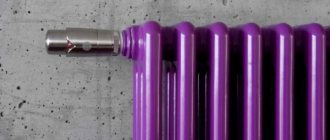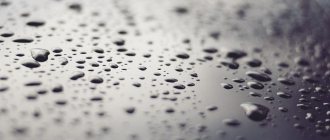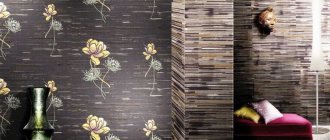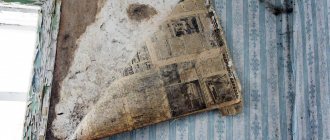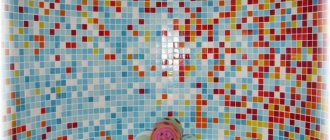Many people, long after wallpapering, become eager to change something in the interior. However, this takes a lot of money and time, so most people leave this desire as a desire. If you are one of those lucky people who once hung non-woven wallpaper, then it’s time to rejoice, because painting non-woven wallpaper is a typical situation. Many manufacturers claim that they can be repainted up to 10 times. If you are not among the lucky ones, don’t be upset, next time you will be lucky because you will know what to buy.
Basic rules for coloring
Proceed with painting only when the canvases are completely dry.
Paint on water will wet the wallpaper again and make it heavy, so don’t complicate your work. This can also lead to damage to the design or even the entire canvas. The order is as follows:
- Before starting work, cover the joints of the wallpaper with doorways and baseboards with masking tape. Cover the floor with protective film. All materials and tools should be nearby, at hand.
- Dilute enough paint to cover the entire amount of work, otherwise your walls will have a different shade.
- Paint the ceiling first and only then start painting the walls.
- Start painting the walls from the bottom and work your way up.
- If the work is carried out with a roller, then do not use foam rubber - it can ruin the texture. Paint over the places where the roller does not reach with a brush.
- Carry out the first painting in 2 layers. Paint the wallpaper once, let it dry for 1 hour, and then repeat the painting.
The paint should be of medium thickness. Thick paint will clog the relief of the design, which will lead to a reduction in the possible number of stains.
The color can only be assessed after complete drying. The gloss will appear in 3 days.
To the question whether it is possible to paint vinyl wallpaper on a paper base, the answer will be this: you can try, but it’s better not to. Even if they have been glued for a long time and have a very dense structure, they can become soggy, lose their pattern, peel off, swell or tear.
Required Tools
— Paint container
— Roller tray with reservoir
— Velor or fur roller
— Pieces of foam rubber (sponges)
— Brushes
How long can you repaint?
Unfortunately, it often happens that after wallpapering a room, it needs to be repainted in a different color. Let's say you didn't like the color or the interior changed. Or maybe, after a certain time, the previous color simply begins to get boring. A reasonable question arises whether it is possible to repaint the wallpaper and how many times it can be repainted.
Gone are the days when cosmetic repairs meant obligatory wallpapering. The furniture had to be taken out, the old wallpaper had to be torn off, and new wallpaper had to be put up. This took a lot of time and effort.
Today, you can only repaint a certain section of the wall in the color you like, and that’s it – the repair is completed.
Manufacturers have taken care of their customers and produce textured wallpaper, the protrusion of which is sufficient to carry out painting work at least five times. Until the drawing is flush with the paint. Usually the quantity is indicated on the packaging; there are specimens intended for re-dying more than ten times.
But in this case you won’t be able to save money.
It is also important what kind of glue they were used to attach to the wall. If cheap glue was used, then after the wallpaper “gains weight” it will slide off the wall under its own weight
It should be borne in mind that matte paints clog up the design, unlike glossy ones, which, on the contrary, emphasize it. It is advisable to use water-based paint; it does not create crusts.
When repainting, you can experiment with the color scheme, for example, a combination of dark blue colors with white paint - you get a pastel color. And when you mix yellow and blue paint, a green tint comes out. If you mix yellow and red it becomes orange.
Bright or colorful combinations are obtained by mixing green and red colors with white paint. You can experiment with your children, the main thing is just not to forget what was mixed with what, in order to repeat this color in the future.
How to paint correctly: step-by-step instructions
Painting begins only after the canvas has completely dried. This usually takes about a day after gluing. They work in the following order.
- Wipe the surface with a dry cloth, removing dust and other contaminants.
- The quality and color of the paint will first be tested on a small area. Allow the surface to dry and evaluate the color.
- If color is used or the paint is diluted, then mix the entire portion at once to obtain a uniform shade.
- When working with a spray gun, it must be pre-set by experimentally selecting the spray angle. A big plus of the spray gun is that painting does not damage the surface and the wallpaper can be repainted more times.
Advice! When working with a roller and brush, use a special tray. Paint is poured into it, and the roller is rolled over a flat surface until it absorbs the paint evenly. Excess paint is also squeezed out on the tray area.
- Paint the wall from bottom to top, evenly distributing the paint over the surface using a roller.
- Hard-to-reach places are passed with a brush.
- Most likely, it will not be possible to paint the surface perfectly the first time. Apply from one to three layers of paint, depending on the characteristics of the mixture and the texture of the wallpaper.
- Before applying the second coat of paint, the previous one must be completely dry.
Wallpaper not intended for painting must be prepared for work.
- Degrease the surface by walking over it with a damp cloth soaked in a solution of dishwashing detergent.
- Prime with a regular primer in one or two layers.
- Make sure the wallpaper adheres firmly to the wall. All air bubbles and loose areas are removed.
This is what concerns the technical side of the process. Now let's look at creative variations on how you can paint the walls.
Wallpaper before gluing
Painting process
Many people prefer to entrust painting of walls to specialists because they do not know how to properly paint wallpaper before painting. In fact, this process does not require special skills or knowledge: it is enough to do everything carefully and in the right sequence. First, prepare all the materials and equipment that you may need in the process of decorating the walls.
In particular, for uniform painting without errors you will need:
- roller, brush or spray – for applying paint to wallpaper;
- paint tray - for even distribution over a brush or roller;
- masking tape - to create borders or protect parts that do not need to be painted.
The choice of roller is extremely important when painting wallpaper. If smooth wallpaper can be easily painted with the most standard rollers, then coatings with a relief texture require a more detailed selection of auxiliary devices.
Foam-based rollers will not ensure uniform distribution of shade on the wallpaper: air bubbles will form on the surface. Velor rollers will not work either: they will only paint the outer layer of wallpaper.
Tip: for painting embossed wallpaper, rollers with soft and long pile are considered the best option.
Use brushes to decorate corners or create smooth patterns and borders. They may also differ in composition and size, but the process of use is the same for each option.
Before brushing corners, wall joints and areas around baseboards and sockets, take care to protect them and cover all unnecessary parts with wide tape.
It is quite possible that during the painting process you will not be able to do without additional equipment: for example, an ordinary sponge will allow you to create stylish decorative prints on the walls, and with the help of stencils you will create a design on a specific theme.
Another useful device is a sprayer: it allows you to evenly distribute the paint over the entire surface of the walls, so the finished wallpaper will not contain inharmonious stains.
The process of painting wallpaper consists of several successive stages:
- The surface of the wallpaper is checked for dryness. If you have just pasted the wallpaper, wait until the glue has completely dried;
- if necessary, some parts of the wallpaper are covered with masking tape;
- paint already diluted in the required proportions is poured into the tray. A fleecy roller is dipped in the finished mixture;
- The painting process starts from the top of the wallpaper. It is advisable to start from the center, smoothly moving to the side parts of the canvas. Using movements from top to bottom, the paint is evenly distributed over the surface of the walls;
- use a brush to paint complex areas of wallpaper;
- After the paint has completely dried, you can remove the masking tape or begin creating another layer.
How to glue wallpaper for painting on walls is written in detail here.
Remember! The coloring process should be carried out gradually. You don’t need to tackle the entire wall at once: gradually move on to the next sections of wallpaper. This work must be done carefully and quickly, since a long dyeing procedure increases the risk of stains and stains.
Pay attention to the possibilities of coloring non-woven wallpaper. If they have a uniform structure, uniform coloring can be achieved by treating the outside of the fabric
If you choose wallpaper with a complex relief texture, it will be more difficult to distribute the paint over the canvas.
Experts recommend painting such wallpaper from the inside out: once saturated, the paint will provide a lasting shade. The protruding parts of the relief pattern will remain white, so your wall will look impressive and stylish.
You can also create transitions between shades on such wallpaper using external painting. After painting, the embossed parts are cleaned with a damp sponge: you may not be able to achieve a snow-white effect, but by creating a lighter pattern you will provide a harmonious contrast.
Structure of non-woven wallpaper
Before purchasing a canvas, we first need to understand what we are purchasing. The structure of such wallpaper consists of strands of cellulose, which are intertwined and form a dense base. Then special polymers are added to this base, thanks to which the strength increases by 2 times.
The resulting product can be considered completely environmentally friendly, because the constituent elements are used every day in the sewing industry, light industry and trade.
The top layer of non-woven fabric is formed by applying relief decor. Next, the layers are pressed, resulting in a dense mass with a smooth patterned surface.
Features of painting the ceiling
Wallpapering the ceiling is popular when decorating rooms.
The algorithm for painting the ceiling is the same, but there are nuances that are important to consider:
- Cover the floor, window sills, and remove furniture with film if possible.
- Paint the ceiling plinth the same color as the ceiling. To protect the wallpaper, apply masking tape along the edge of the baseboard.
- It is better to work during daylight hours to evaluate the results in daylight and electric light.
- If primer treatment is required, it must have the same base as the paint. You can start painting the ceiling after the primer has completely dried.
- After applying the first layer, turn on the light and inspect the ceiling. If there are gaps, paint over them.
- The ceiling is painted in 2 layers. The first is distributed parallel to the window, the second - perpendicular.
- New wallpaper on the ceiling cannot be painted for 1-3 days until the glue dries.
Is it possible to glue wallpaper over paint?
And if you decide to glue the wallpaper directly onto the paint, then you need to determine what paint the walls are painted with. If it is water-based paint , then initially the wall must be coated with a composition: solvent plus primer in a one-to-one ratio.
After the first layer has dried, you need to cover it with this solution again and wait until it dries completely. As a result, the solvent will corrode the paint and the primer will be able to soak into the wall.
For gluing, a special mixture of wallpaper glue and PVA in equal proportions, which is applied both to the wallpaper and to the wall.
If the paint is oil-based, then this complicates the situation. The wall will have to be treated with coarse sandpaper, and then only the prepared mixture of PVA and primer is applied in equal proportions. For glue, use a mixture of wallpaper glue and PVA 2:1.
Painting technology
To apply paint to the wallpaper, use a roller and brushes. First, hard-to-reach places are painted with a brush, such as cracks, areas located near radiators, window slopes, all corners of the room, and doorways. Then they proceed to smoother areas, carefully painting them with a roller. Large areas can be treated with a spray bottle.
Preliminary and thorough mixing of the paint is mandatory so that the color is uniform. For the job, you will also need a paint tray and masking tape, which can be used to limit those areas that should not be painted (ceiling, baseboard, etc.).
The first coat is usually considered a primer because there is a possibility of areas that will be poorly painted. This especially happens with wallpaper with a deep textured pattern. After the first layer has dried, the procedure should be repeated.
The technology of applying paint to wallpaper consists of the following steps:
- The wallpaper paste must be completely dry after pasting, i.e. Wallpaper must be dry before painting.
- Cover areas that do not need to be painted with masking tape. Using a brush, apply paint to hard-to-reach places and in places where the tape is covered.
- Pour some paint into the tray and dip the roller. It is preferable to use with long pile in order to carefully paint over the relief pattern.
- It is better to apply paint to wallpaper from the window and in the direction from top to bottom.
The interior design can be thought out in such a way that drawings or color stripes are applied to the wallpaper
It is important to know that you need to paint on the finished base coating, i.e. on the second coat of paint
An option for forming patterns can be a prepared stencil.
Finishing with varnish is allowed, which will give the wallpaper and paint additional protection from mechanical damage.
How to glue non-woven wallpaper for painting?
In order to get started, you need to check the presence of glue. For non-woven wallpaper, simple glue marked “universal” will not work; it should be used for paper canvases. In the case of wallpaper for painting, you will need a special adhesive composition specifically for these models.
The work consists of several stages .
The wall is cleaned of old coating , which is removed with sharp objects and soapy water. The wall surface is checked for chips and other defects that will be noticeable after the material is applied if they are not removed in time.
If there are irregularities, they are plastered . After this, you need to wait for the plaster to dry completely, and apply a layer of soil mixture on top of it, after which you again wait until the treated surface is completely dry.
You need to start pasting from the left side of the window, moving counterclockwise .
To ensure that the corners and strips are glued evenly, you should use a level and plumb line, because without their help you can make errors in measurements.
Glue is not applied to non-woven wallpaper, but rather intended for application of the material is covered with it The required parts of the material are cut off and applied to the surface on which the adhesive solution was previously applied. Applying the sheets should begin from the top, gradually smoothing the surface of the material.
When the material fits tightly to the wall, it is smoothed with a brush, moving from the middle towards the edges. Excess pieces are cut off using a construction knife or scissors. You need to check for excess pieces near the baseboards and the top of the product.
About painting vinyl wallpaper
Can you paint or not?
I’ll say right away that there are special paintable vinyl wallpapers on sale, i.e. The question of painting this material, in principle, disappears by itself. But is it possible to paint wallpaper without painting? It all depends on what type of vinyl wallpaper is glued to the wall.
As you know, this finishing material comes in two types:
Paper based. It is not advisable to paint such canvases, as there is a risk of moisture penetrating under the top vinyl layer, which will lead to them sticking off the wall. True, some paper-based wallpapers successfully withstand this operation, but, in any case, you will have to make a decision at your own peril and risk;
On a non-woven basis. These fabrics are more resistant to moisture, so there is no risk of them peeling off. However, during the painting process some problems may arise - uneven coloring as a result of the porous structure of the vinyl foam, as well as the appearance of the color of the wallpaper. I will tell you how to solve them below.
From this we can conclude that it is better to immediately purchase trellises for painting if you plan to repaint the walls over time.
Which paint to choose
To paint vinyl wallpaper, use water-based paint. The fact is that this paint and varnish material has good adhesion. In addition, it has several other important advantages:
- No smell.
This is due to the fact that the composition does not contain organic solvents - water is used instead; - Environmental friendliness
. After painting the walls, it is absolutely not necessary to leave your home, as is the case with using oil paint; - Drying speed
. This indicator depends on the time during which the water evaporates from the surface of the walls, i.e. on average, the paint dries within a few hours;
- Possibility of tinting
. Thanks to this, you can give the walls any color or shade. The only thing is that you need to choose the right color (combination of colors) and its proportions; - Durability
. High-quality water-dispersed paints do not crack or lose color, as a result of which they can last more than 10 years.
It must be said that there are several types of water-dispersion paints on sale:
- Acrylic;
- Latex;
- Silicone, etc.
This usually confuses newbies and makes it difficult to choose. In reality, it does not matter at all what type of polymer the paint contains.
The main thing is to pay attention to the following characteristics when choosing:
Gloss level. The coating can be matte, semi-gloss, or less often glossy;
Level of moisture resistance and abrasion. Conventionally, paints can be divided according to this indicator into three types - non-moisture-resistant, moisture-resistant and water-resistant. If the former cannot withstand the effects of the vaga at all, then the latter can be subjected to careful wet cleaning. Waterproof ones can withstand direct contact with water and even detergents.
The choice of moisture resistance depends on the room in which you want to paint the wallpaper. For example, you can even use non-moisture resistant paint in the bedroom. For a kitchen or children's room, it is more advisable to use a waterproof coating.
Another important point is the quality of the paint, which depends solely on the manufacturer. Below are paints and varnishes from some manufacturers that have proven themselves well:
Prices are current in summer 2021.
Varnish coating
Many craftsmen decide to use varnish to cover the walls, this is justified by several factors:
- Sophisticated look. The appearance of the wall is transformed and acquires a glossy shade , and the color of the wallpaper changes slightly.
- The varnish increases the resistance of the material to mechanical damage and accidental abrasion of the surface.
- Additional water resistance. After covering the product with a varnish solution, you can carry out any work to remove dust and dirt with a wet cloth and not worry about damaging the paint structure.
It is important to know that after the varnish layer has dried, unpleasant moments may appear on the wall:
- if there were defects and scratches on the wall, then when it is covered with a layer of varnish, the irregularities will become more noticeable and clearer than before;
- without varnish, wallpaper can be removed from the wall if such a need arises, and after varnish this process will turn into a painful task;
- the varnish solution after drying or even during the application process can seriously damage the joints and edges of the canvas;
- there is a high probability that the composition will show through the wall.
When working with varnish, it is important to know that it is applied to a pre-painted wall surface.
Vinyl wallpaper and its features
Paintable vinyl wallpaper is a reliable and versatile material that allows you to save time on decorating and replacing cladding. Even 20 years ago, people re-walled their apartments almost every year. The reasons for this action could be different, someone was tired of the color, and someone accidentally smeared the coating, and all the work had to be done again.
Since the wallpaper was mainly paper, difficulties often arose both when applying the coating to the wall and when dismantling it.
The material easily sticks to the wall and can be painted
With the advent of vinyl wallpaper, the difficulty in carrying out installation work has disappeared, since the material is easily glued to the wall and can be easily removed from the surface.
Many manufacturers immediately began to create not only vinyl-based patterned wallpaper, but also paintable wallpaper. Initially, people did not have confidence in this product, and the question of whether vinyl wallpaper could be painted was often asked in all construction stores.
Over time, all mistrust in vinyl roll products disappeared, as the material has proven itself to be a reliable, high-quality product with a long service life.
Vinyl wallpaper is a two-layer or three-layer material. The bottom layer is usually thick paper or non-woven material, and the top layer is polyvinyl chloride (PVC). The middle layer is a masking layer that hides all surface irregularities. You can see a visual representation of the composition of vinyl wallpaper in the diagram below.
Types of vinyl wallpaper
Today, professionals in finishing work distinguish 3 types of vinyl wallpaper:
- Foamed. An excellent thick roll material that helps remove all the unevenness of the wall covering and various surface defects from the human eye. This cover can be either plain or embossed, have a preliminary color or be white or beige (for painting). Foam wallpaper is susceptible to mechanical damage due to its structure (large layer of PVC), so additional painting of the surface will not only give the product a new look, but also protect it from various scratches and contact with any objects, creating a protective layer.
- Kitchen wallpaper. Wall products intended for the kitchen have a high density, average thickness and little relief surface, since the material often gets dirty and needs constant care. The surface of kitchen vinyl wallpaper can be washed with water, removing all stains. If some stained areas cannot be cleaned, the coating can be repainted. Any paint intended for interior decoration can easily be applied to this type of wallpaper.
- Flat wallpaper. Only this type of wall material from the entire range of vinyl products is not intended for painting. Since it is often decorated with ornaments of different colors, and if you paint the wallpaper in one tone, the entire type of product can be ruined.
Characteristics of vinyl wallpaper
Vinyl wallpaper is resistant to mechanical damage
Every interested person will ask the question: “How can such different types of coatings have the same general characteristics?”, but this is true. Since different types of vinyl wallpaper are created by changing the thickness of the layers and the shape of the outer PVC surface, and the composition of the material does not change.
Vinyl wallpaper has the following characteristics:
- the excellent density of the material allows the product to be pasted by people unfamiliar with this process, since the wallpaper is not easy to tear and damage;
- are not afraid of mechanical damage (except for foam wallpaper without color);
- a huge selection of products with different relief;
- wallpaper does not fade in the sun like paper wallpaper;
- good moisture resistance. For more information about the properties of the material, watch this video:
Paint selection
Now let’s take a closer look at which paint to choose for non-woven wallpaper. It should be said right away that the choice of dyes is particularly small - they all must be water-dispersed.
These types of paint coatings include the following compositions:
- Latex;
- Acrylic;
- Water-based.
Latex paint
Latex mixtures are a good option, however, the price for them is quite high, so it is more advisable to opt for acrylic mixtures. You can also use a regular water-based emulsion, but in this case you need to pay attention that it does not contain solvent or harmful components.
Advice! It is best to purchase paintwork with water-repellent properties. This will allow you to wash the surface of the walls, which may be necessary after a couple of years.
In the photo - a roller with a paint tray
Can they be painted: pros and cons
Non-woven wallpaper can be painted; for this purpose, special rolls are produced for applying paint and varnish.
Wallpaper of this type is made from natural cellulose, which distinguishes it from ordinary paper-type canvases by its strength, tensile strength and smoothness.
Based on the composition, this type of wallpaper is divided into two types:
- non-woven,
This includes two-layer products with a compacted first layer and a top relief application. Non-woven wallpaper is produced specifically for the painting procedure in white, milky and cream tones.
If the products are not intended for dyeing, this can be easily understood by the brightness of the color present on the canvas.
made on non-woven base.
Wallpaper made on a non-woven basis is called non-woven wallpaper by many craftsmen, but this is not so. The composition of these products differs from the usual wallpaper. A mixture of another material is applied to the substrate: polyvinyl chloride with an all-foam texture is often used. On store shelves you can find textile fabrics with a non-woven base.
When painting wallpaper, it is important to know some of the subtleties of this process:
when choosing, it is better to focus on rolls marked “intended for painting”
After purchasing this product, the owner of the room will be calm, because nothing will happen to the wallpaper after applying the coating layer;
if the choice was made of vinyl wallpaper on a non-woven basis, then it is important to know that such materials are painted only with acrylic compounds;
manufacturers claim that high-quality non-woven wallpaper can be painted up to ten times, but as the practice of craftsmen shows, this amount varies from five to eight times. Of course, a lot depends on the thickness of the canvas and the nature of the relief on it;
Products made of thin fabric and not marked “for dyeing” can be treated with a brush and paints no more than two times;
It is more difficult for paint to penetrate into wallpaper containing polyvinyl chloride, which may result in a pale tint of the surface. The downside of painting is considered to be the deterioration of the positive properties of the material, such as the breathability of the canvas and the transmission of moisture
After the top layer is clogged with a layer of paint, these properties cease to be the advantages of non-woven wallpaper
The disadvantage of dyeing is considered to be the deterioration of the positive properties of the material, such as the breath of the canvas and the transmission of moisture. Once the top layer is clogged with a layer of paint, these properties cease to be the advantages of non-woven wallpaper.
The undeniable advantages are the scope for creative thinking of people who are accustomed to embodying their fantasies not only in life, but also on the wall. If you get bored with one color, you can replace it; besides, wallpaper with an additional layer of paint is easier to wet clean.
Specifications
The properties of non-woven wallpaper in technical terms can be divided into advantages and disadvantages.
Positive properties include:
- The ability of the material to be vapor permeable.
- Fire resistance.
- Easy to install.
- Price available for all categories of consumers.
- Resistance to mechanical stress and periodic friction.
- Ability to repel water.
- Easy to separate the base layer from the outer layer.
- Resistance to sun rays.
- Resistance to dust accumulations.
This property allows the canvases to breathe in their pure form on the walls of the room.
It is important to know that this does not apply to those products that contain polyvinyl chloride.
Unlike paper wall materials, these products are flame resistant and are never too secure.
These products are not subject to tearing, bending or stretching.
The glue does not need to be applied to the rolled out roll; it just needs to be distributed over the surface of the wall.
When choosing, you can notice wallpapers with a low price and the possibility of further coloring according to the structure of their surface. Also in construction stores there are models with a high price; these products contain silk threads, which give the texture a special sophistication.
This is important in rooms with increased contact with the wall surface, for example, in the kitchen or hallway.
This is one of the main advantages of the material, allowing it to be used in kitchen areas. Some masters think through a design where the wallpaper fits appropriately into the interior of the bathroom. In addition, you can wash the surface by adding household chemicals to the water.
This is beneficial for those craftsmen who wish to peel off the vinyl base in the future and glue the interlining as the top layer to the base of the material. If you follow the manufacturer's recommendations and treat the surface of the product with care, the wallpaper can withstand up to ten years of use on the walls of the room.
When exposed to direct sunlight, they retain their rich color and structure.
Experts say that such products do not accumulate dust on their surface, which is important when people prone to allergic reactions live in an apartment or house.
Like any product, non-woven wallpaper has a number of disadvantages , such as:
- The base of the material tends to be translucent, and this is not always beneficial for the owners of those walls where there are significant defects and scratches.
- A specific aroma that lasts in a room for up to two or three months.
- If there is a vinyl layer on the outer surface of the product, then its edges are very vulnerable, and the slightest friction can damage the texture elements.
In order to avoid unpleasant toxic fumes, it is important to take care of the correct purchase of material. It should be from a reputable brand and purchased from a qualified building supply store.
This is especially important to consider in homes where there are small children and pets.
Advantages and disadvantages
As noted earlier, liquid wallpaper does not peel off after painting. The thing is that a diluted solution is applied to the wall, and the design can be made with your own hands. A layer of liquid wallpaper promotes noise reduction, which means that extraneous noise from the entrance or street will not enter the room. The ease of applying liquid wallpaper allows any adult to make repairs; this does not require special skills or knowledge.
The advantages of vinyl, non-woven and glass wallpaper were partially described in the previous section, but the only disadvantages can be noted are their high cost. Unfortunately, even cosmetic repairs cost a pretty penny.
How to paint
How to paint wallpaper.
Not all dyes are suitable for non-woven trellises. Pasted surfaces should be painted only with water-dispersible types. If you plan to wet clean a room, then they give preference to products with repulsive characteristics. There are 3 paint options:
- Water-based . An inexpensive product should not contain solvents or substances hazardous to human health. It's difficult to get rich shades.
- Acrylic . Durable material will give the walls an attractive look. Will quickly recoup the high cost.
- Latex. Beautiful expensive paints have a wide color palette and a variety of brands. The product will retain its original qualities for a long time and protect the wallpaper from damage.
In hardware stores, paints are often presented as neutral white. The buyer is offered tint colors that are mixed with a light base. The more coloring pigment, the more intense the final result.
Varnish coating
A pleasant glossy shine instantly transforms boring walls. Even the most inexpensive trellises look elegant. Varnish makes the coating more resistant to mechanical stress and protects against abrasion. The wallpaper is not afraid of water, and when cleaning it is enough to simply wipe off the dust with a damp sponge.
Small irregularities and scratches on the varnish layer will become clear and bright. The solution may damage the edges of the fabric at the joints, causing the paper to come off. The finishing material is difficult to remove from the surface and impossible to repaint in a different shade.
